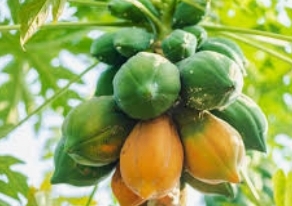How to Start Pawpaw Farming in Nigeria: Pawpaw farming, also known as papaya farming, is an excellent agricultural venture in Nigeria due to the country's favorable climate and growing demand for this tropical fruit.
This guide provides a comprehensive overview of how to start pawpaw farming in Nigeria, including site selection, cultivation techniques, and marketing strategies.
Read Also: How to Start a Hotel Business in Nigeria
How to Start Pawpaw Farming in Nigeria
Site Selection:
Choosing the right location is crucial for successful pawpaw farming.
Consider the following factors:
a. Climate: Pawpaw thrives in tropical and subtropical climates. The average temperature should range between 25 to 30 degrees Celsius.
b. Soil: Well-drained, fertile soil with a pH range of 6 to 7 is ideal for pawpaw cultivation. Conduct a soil test to determine its suitability.
c. Sunlight: Pawpaw plants require ample sunlight exposure. Select a site with at least six hours of direct sunlight daily.
Variety Selection:
Different pawpaw varieties exist, and it is important to choose the right one based on factors such as taste, size, disease resistance, and market demand. Some popular varieties in Nigeria include Solo, Red Lady, and Tainung.
Seedling Production:
Pawpaw can be propagated from seeds or vegetative cuttings. However, it is recommended to use seedlings from reputable nurseries to ensure quality and uniformity. Prepare the nursery beds, sow the seeds, and provide adequate water and shade during the germination period.
Land Preparation:
Clear the selected land of weeds, stones, and debris. Plow the soil to a depth of 30 centimeters and incorporate organic matter such as compost or well-rotted manure. Ensure proper leveling of the land for effective water drainage.
Planting and Spacing:
Transplant the healthy seedlings into the prepared field when they reach a height of around 15-20 centimeters. Maintain a spacing of 2 to 3 meters between plants and rows to allow for proper growth and easy access for cultural practices.
Irrigation and Water Management:
Pawpaw requires regular and adequate water supply. Employ a drip irrigation system for efficient water distribution and to prevent waterlogging. Mulching around the plants helps retain soil moisture and suppress weed growth.
Fertilizer Application:
Apply a balanced fertilizer during the planting phase and subsequent stages of growth. A soil test will determine the appropriate fertilizer composition. Regularly monitor nutrient levels and make adjustments accordingly.
Pest and Disease Management:
Common pests affecting pawpaw include aphids, fruit flies, and mites. Adopt integrated pest management practices such as regular scouting, proper sanitation, and judicious use of organic or chemical pesticides. Diseases like powdery mildew and black spot can be managed through proper spacing, good air circulation, and timely application of fungicides.
Harvesting and Post-Harvest Handling:
Pawpaw fruits are typically ready for harvest within 6 to 8 months after planting. Harvest when the fruits attain a uniform yellow color and give slightly to gentle pressure. Handle the fruits carefully to prevent damage and store them in cool, dry conditions to prolong shelf life.
Conclusion:
Starting a pawpaw farming venture in Nigeria can be a lucrative and rewarding business opportunity. By selecting suitable varieties, ensuring proper site selection, implementing effective cultivation practices, and employing sound marketing strategies, farmers can achieve success in this industry.
Remember to stay updated with the latest farming techniques, attend workshops, and network with experienced farmers to continuously improve your knowledge and maximize your pawpaw farming productivity and profitability.

